#legal history
Text

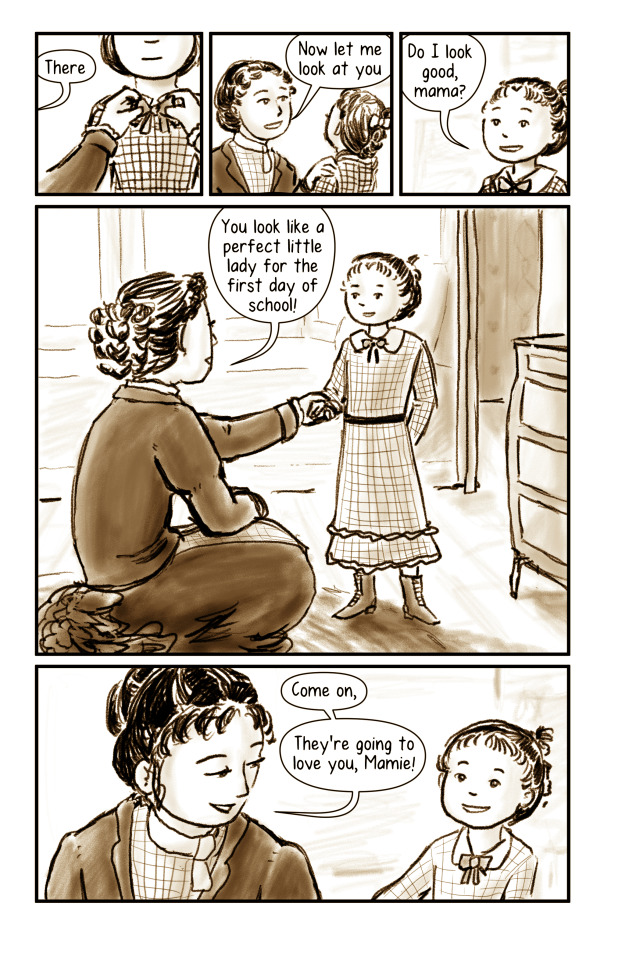
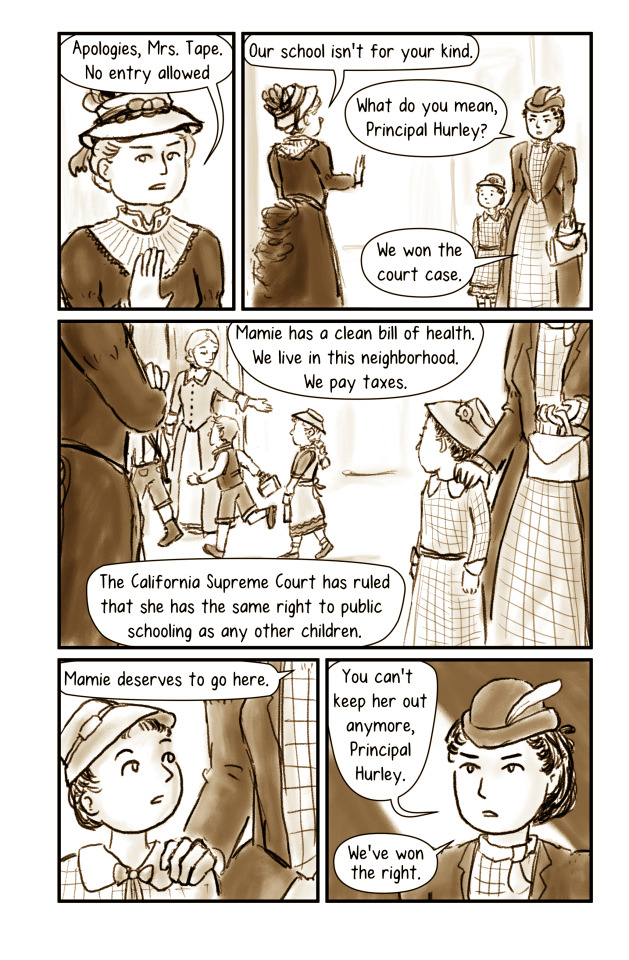
in my pursuit of ever-increasingly niche comics, I drew a 13 page comic about Tape v Hurley, a court case about Chinese-American school segregation in 1885. The rest of the pages are after the readmore, as well as on AO3 here. More obsure Chinese American court case comics are there, as well.

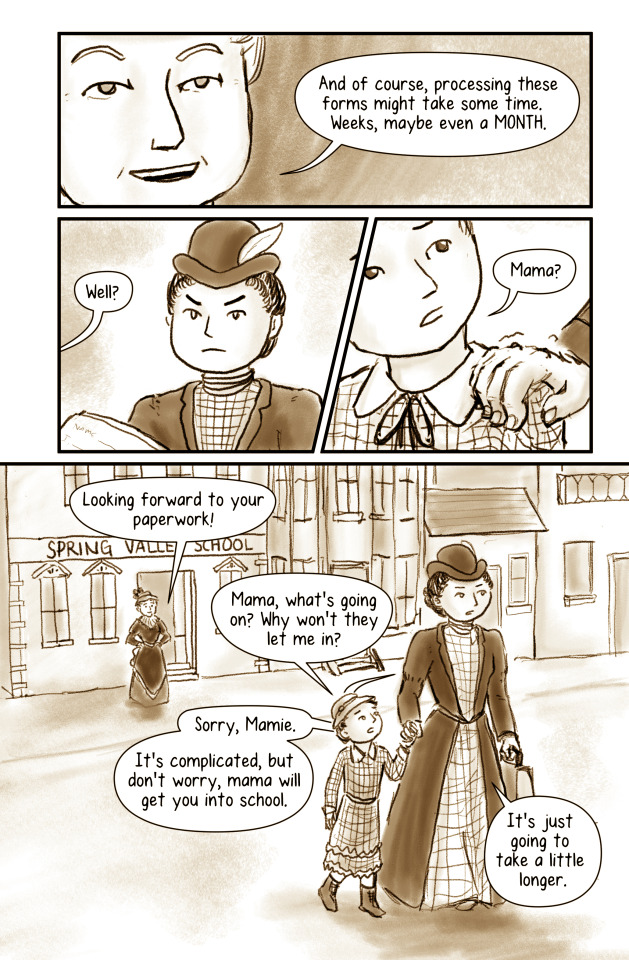
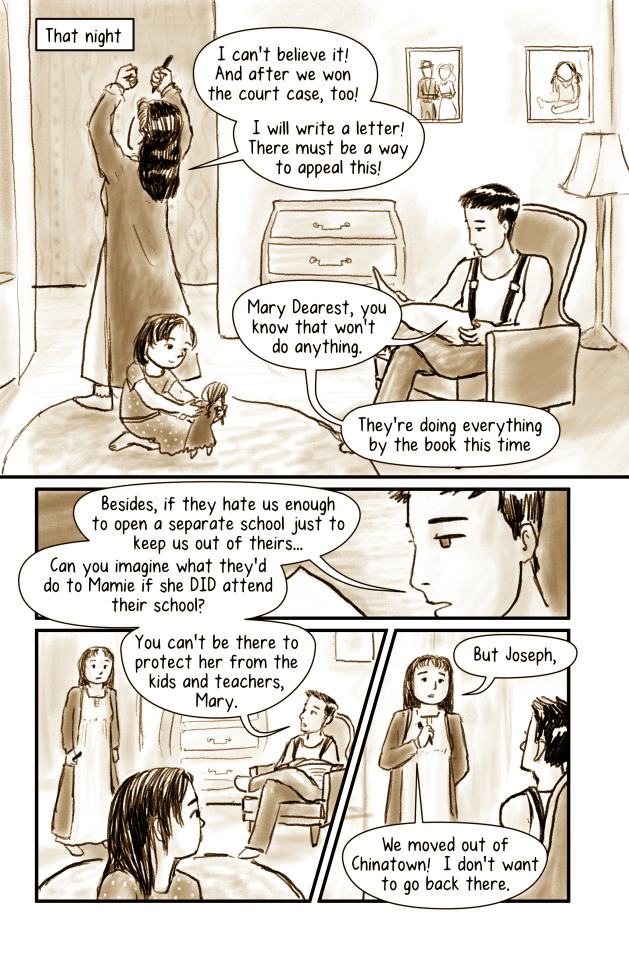
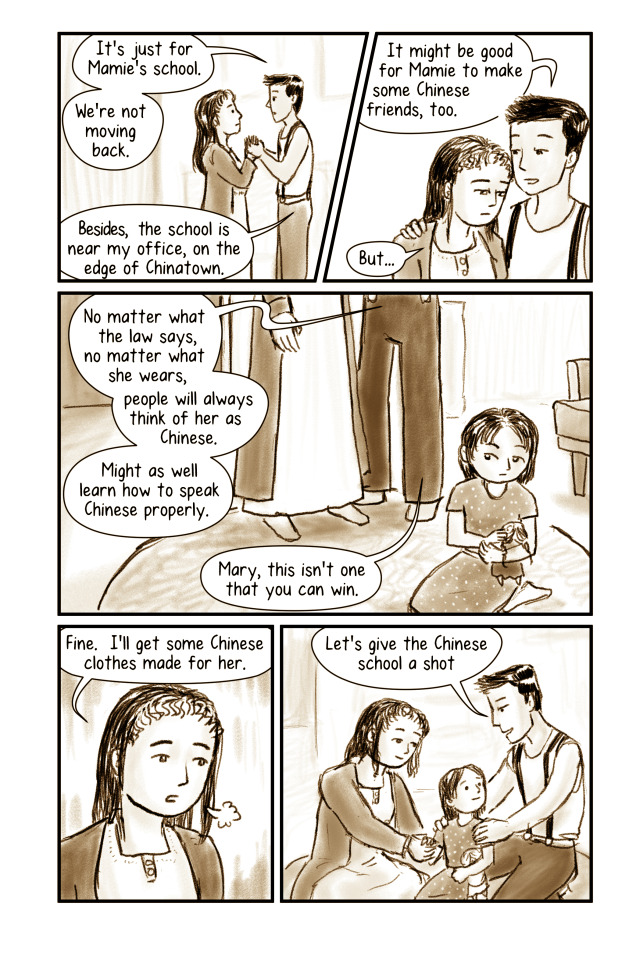
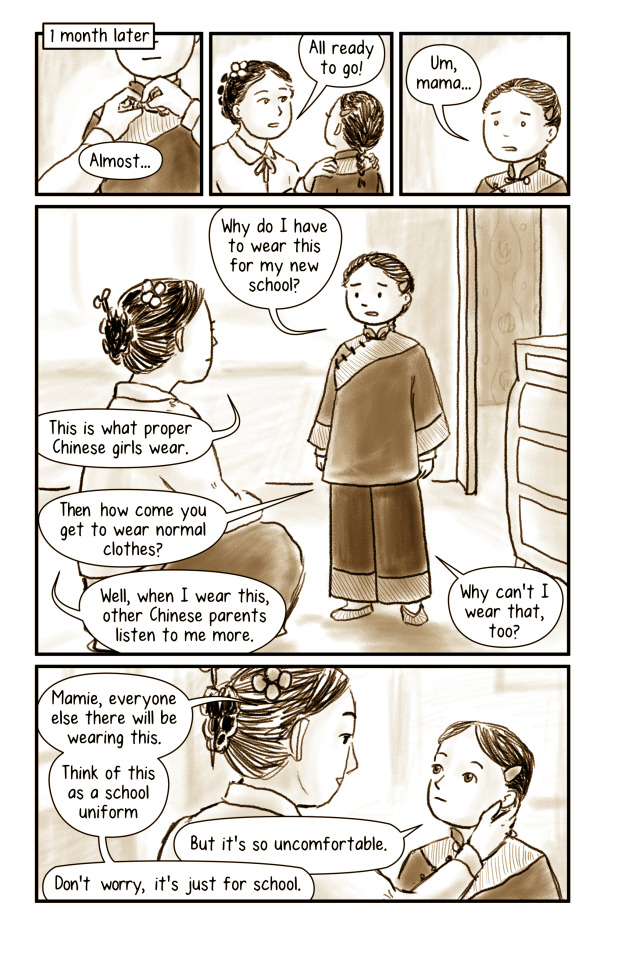
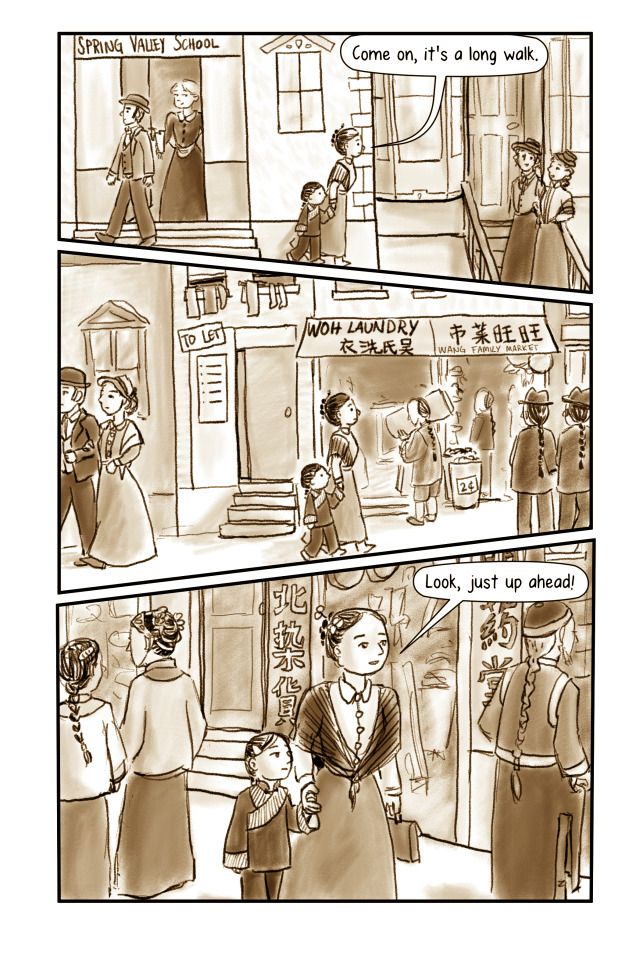
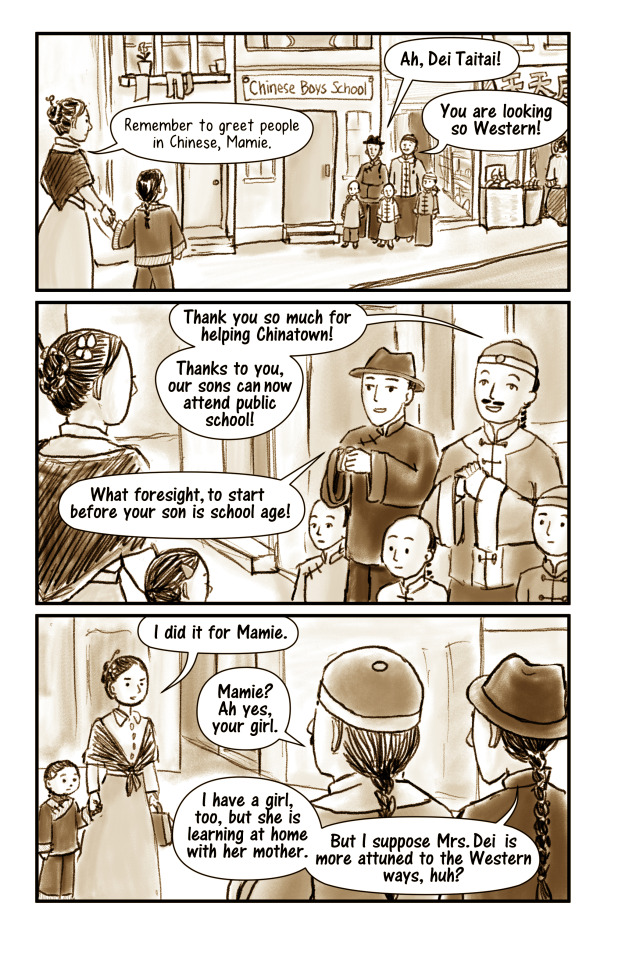
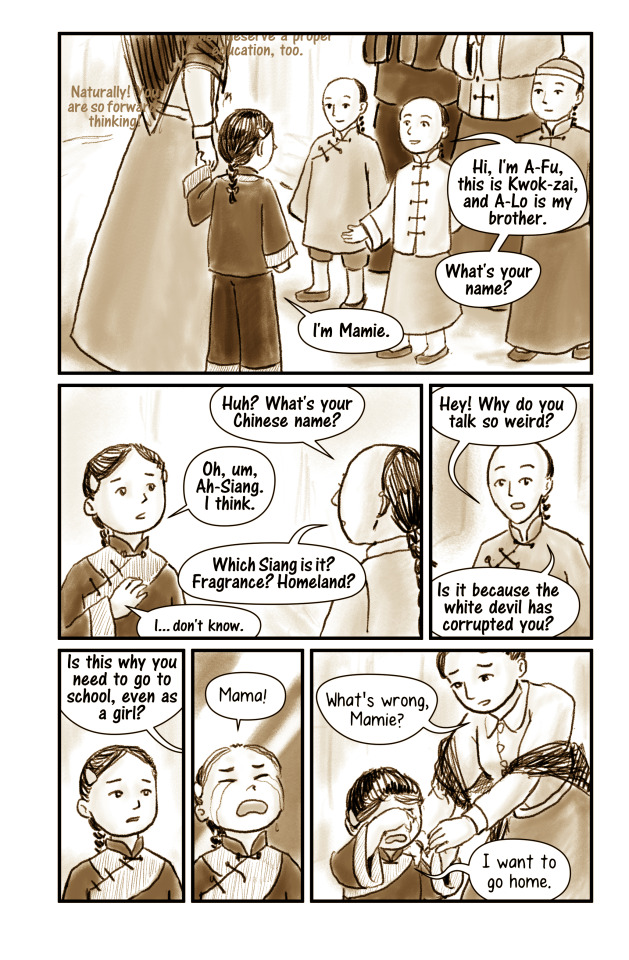
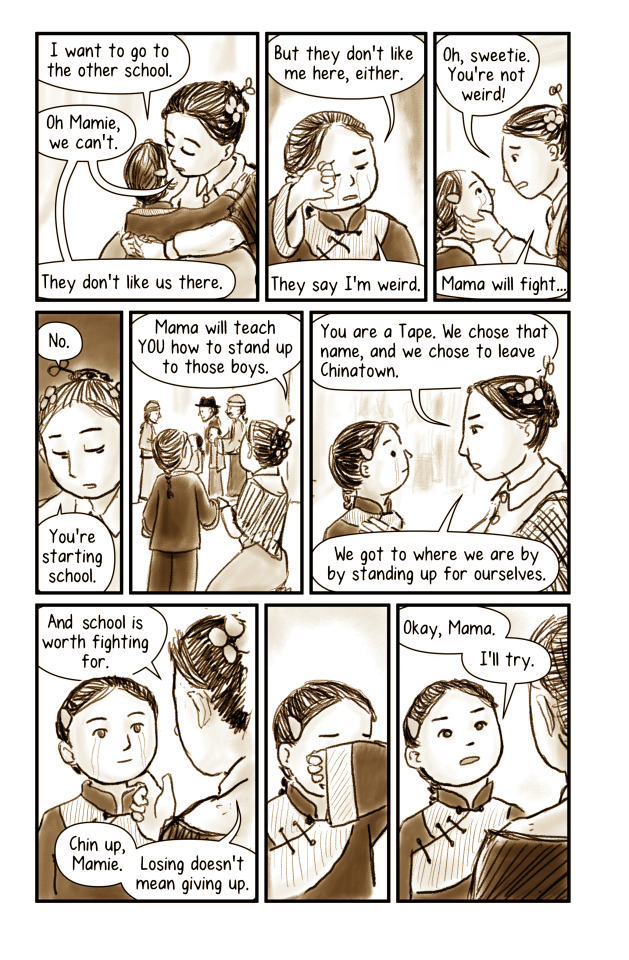
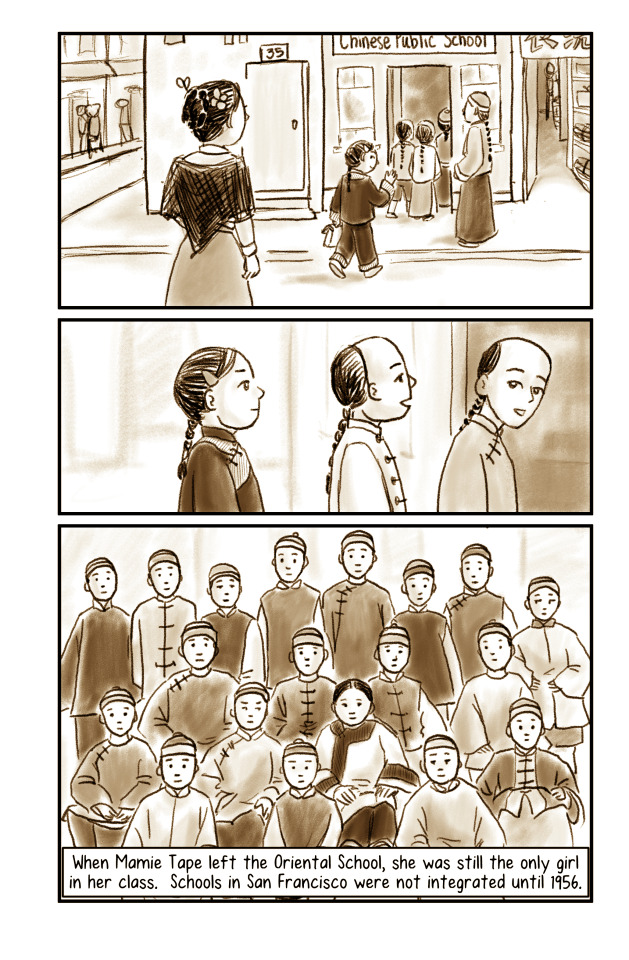
Historical Notes
Mary and Joseph Tape were not born in America, but their names and identities were very much formed in America. Joseph Tape was born Jeu Dip in Guangdong, China, immigrated the America when he was twelve, and spent his teenage years working as a house servant in an Irish household. Mary arrived in America at the age of eleven, and was found and raised as Mary McGladery in a Protestant orphanage as the only Chinese child amongst ~80 children. Both Mary and Jeu spent their formative years amongst White Christian families, so when Jeu Dip and Mary married in 1875, little wonder that Jeu picked the English name of Joseph Tape -- Joseph to match with Mary, and the German last name Tape as a nod to his former name of Dip.
The Tape family lived about 14 blocks outside of Chinatown, in a primarily white neighborhood. They dressed in Western clothing, spoke English at home, and Mamie grew up playing with non-Chinese kids. Naturally, they wanted their children to attend the local elementary school, a mere 3 blocks from their home. The principal, Ms. Hurley, denied her entrance, claiming that she was “filthy and diseased.” At the time, there was no public school option for Chinese children -- the 1870 state law stipulated separate schools for “African and Indian children” only, not Chinese. The Tape family, with the help of the Chinese Six Companies, their church, and the Chinese consulate, decided to sue, claiming that the 1880 California school code guaranteed everyone a right to public education and that this was a violation of the 14th Amendment.
They won.
But this was 1885, three years after the passage of the Chinese Exclusion Act and six years before Plessy v Ferguson. Regardless of what the California Supreme Court might decide, public sentiment was on the side of the San Francisco school district. Determined to keep out this “invasion of Mongol barbarism”, the California State Legislature passed a law permitting separate schools for Chinese children, which then allowed Principal Hurley to reject Mamie Tape once more.
While Mamie was rejected from the Spring Valley Elementary School for being Chinese, she also had a hard time fitting in to the Chinese public school. The Chinese merchants saw Western education as something primarily for boys. (Their girl children learned from their mothers at home.) Mamie, a girl dressed in Western clothes, would have stood out like a sore thumb. The final panel of the comic was based on a photo from three years later, and even then, Mamie was the only girl.
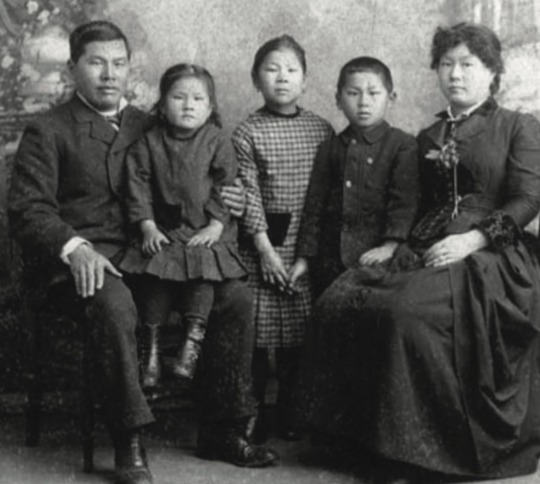
Places where I fudged the history: Frank, Mamie’s younger brother, was actually six years old and should have been more present in the comic, but I wante to keep the focus on Mamie and Mary. Also, Mamie had actually shown up to her first day of school in Western clothes. An earlier draft of the comic had a separate arc involving Mamie feeling rejected at school and Mary buying her some Chinese clothes, but that got too long and complicated.
Much of this was drawn from Mae Ngai’s book about the Tape family and their experiences as 2nd and 3rd generation Chinese Americans, titled “The Lucky Ones.”
----------
Here is Mary Tape's letter to the San Francisco School Board, 1885:
1769 Green Street.
San Francisco, April 8, 1885.
To the Board of Education -
Dear Sirs: I see that you are going to make all sorts of excuses to keep my child out off the Public schools. Dear sirs, Will you please to tell me! Is it a disgrace to be Born a Chinese? Didn’t God make us all!!! What right have you to bar my children out of the school because she is a chinese Decend. They is no other worldly reason that you could keep her out, except that. I suppose, you all goes to churches on Sundays! Do you call that a Christian act to compell my little children to go so far to a school that is made in purpose for them. My children don’t dress like the other Chinese. They look just as phunny amongst them as the Chinese dress in Chinese look amongst you Caucasians. Besides, if I had any wish to send them to a chinese school I could have sent them two years ago without going to all this trouble. You have expended a lot of the Public money foolishly, all because ofa one poor little Child. Her playmates is all Caucasians ever since she could toddle around. If she is good enough to play with them! Then is she not good enough to be in the same room and studie with them? You had better come and see for yourselves. See if the Tape’s is not same as other Caucasians, except in features. It seems no matter how a Chinese may live and dress so long as you know they Chinese. Then they are hated as one. There is not any right or justice for them.
You have seen my husband and child. You told him it wasn’t Mamie Tape you object to. If it were not Mamie Tape you object to, then why didn’t you let her attend the school nearest her home! Instead of first making one pre tense Then another pretense of some kind to keep her out? It seems to me Mr. Moulder has a grudge against this Eight-year-old Mamie Tape. I know they is no other child I mean Chinese child! care to go to your public Chinese school. May you Mr. Moulder, never be persecuted like the way you have persecuted little Mamie Tape. Mamie Tape will never attend any of the Chinese schools of your making! Never!!! I will let the world see sir What justice there is When it is govern by the Race prejudice men! Just because she is of the Chinese decend, not because she don’t dress like you because she does. Just because she is descended of Chinese parents I guess she is more of a American then a good many of you that is going to prewent her being Educated.
Mrs. M. Tape
#original comic#chinese american history#legal history#turns out there's a lot of chinese american court cases#that i have a lot of feelings about#my comic#mine
1K notes
·
View notes
Photo

A manicule, but make it a unicorn. A unicornicule?
This wonderful little surprise appeared in the margins of a 1505 book of English canon law.
#unicorn#marginalia#margin mondays#annotation#16th century#English law#legal history#canon law#latin#rare books#old books#riesenfeld center#umn law#university of minnesota#law library
3K notes
·
View notes
Note
Why was queens pardoning prisoners seen as good? Like murders and sexual assaulter ect? Wouldn’t the public be against that?
This is an area where I think Foucault was actually right:
"...The public execution is to be understood not only as a judicial, but also as a political ritual. It belongs, even in minor cases, to the ceremonies by which power is manifested....
The public execution, then, has a juridico-political function. It is a ceremonial by which a momentarily injured sovereignty is reconstituted. It restores that sovereignty by manifesting it at its most spectacular. The public execution, however hasty and everyday, belongs to a whole series of great rituals in which power is eclipsed and restored (coronation, entry of the king into a conquered city, the submission of rebellious subjects); over and above the crime that has placed the sovereign in contempt, it deploys before all eyes an invincible force. Its aim is not so much to re-establish a balance as to bring into play, as its extreme point, the dissymmetry between the subject who has dared to violate the law and the all-powerful sovereign who displays his strength. Although redress of the private injury occasioned by the offence must be proportionate, although the sentence must be equitable, the punishment is carried out in such a way as to give a spectacle not of measure, but of imbalance and excess; in this liturgy of punishment, there must be an emphatic affirmation of power and of its intrinsic superiority. And this superiority is not simply that of right, but that of the physical strength of the sovereign beating down upon the body of his adversary and mastering it by breaking the law, the offender has touched the very person of the prince; and it is the prince - or at least those to whom he has delegated his force - who seizes upon the body of the condemned man and displays it marked, beaten, broken. The ceremony of punishment, then, is an exercise of 'terror'...
The sovereign power that enjoined him to kill, and which through him did kill, was not present in him; it was not identified with his own ruthlessness. And it never appeared with more spectacular effect than when it interrupted the executioner's gesture with a letter of pardon...The sovereign was present at the execution not only as the power exacting the vengeance of the law, but as the power that could suspend both law and vengeance. He alone must remain master, he alone could wash away the offences committed on his person; although it is true that he delegated to the courts the task of exercising his power to dispense justice, he had not transfered it; he retained it in its entirety and he could suspend the sentence or increase it at will." (emphasis mine)
Michel Foucault, Discipline and Punish, ch. 2
Unlike a modern conception of criminal justice, which is premised as an objective, rational, truth-seeking process in which precise identification of the right suspect and their level of guilt and the appropriate nature of their punishment, criminal justice systems in premodern Europe (although not necessarily limited to the same) were meant to emphasize the terrifying arbitrariness of royal power. With rituals put in place in order to ensure guilt through public (often coerced) confessions, the point wasn't whether the sheriff and the judge had "got the right man" or whether "the punishment fits the crime," but that the king could either enact public displays of bodily obliteration or public displays of mercy at their sole discretion.
In a sense, the pardoning of the guilty was a necessary justification for the deliberately disproportionate brutality of a pre-carceral system of punishment. This promoted the logic of submission to the guilty and innocent alike: if the king could sentence you to the ultimate physical dehumanization whether or not you were guilty, the only hope was either the mountain and forest refuge of the outlaw or the hope of a pardon as a quasi-divine act of unearned grace.
58 notes
·
View notes
Text

"The Boldt Decision was, to say the least, a watershed moment in the history of the Pacific Northwest and beyond. A half century on, Wilkinson has given us the inside story of this critical case: the labor that went into its manifestation, its implications for all who live in these places, and most importantly the Indigenous land, water, and more-than-human relations that are at its core. A must-read."
14 notes
·
View notes
Text
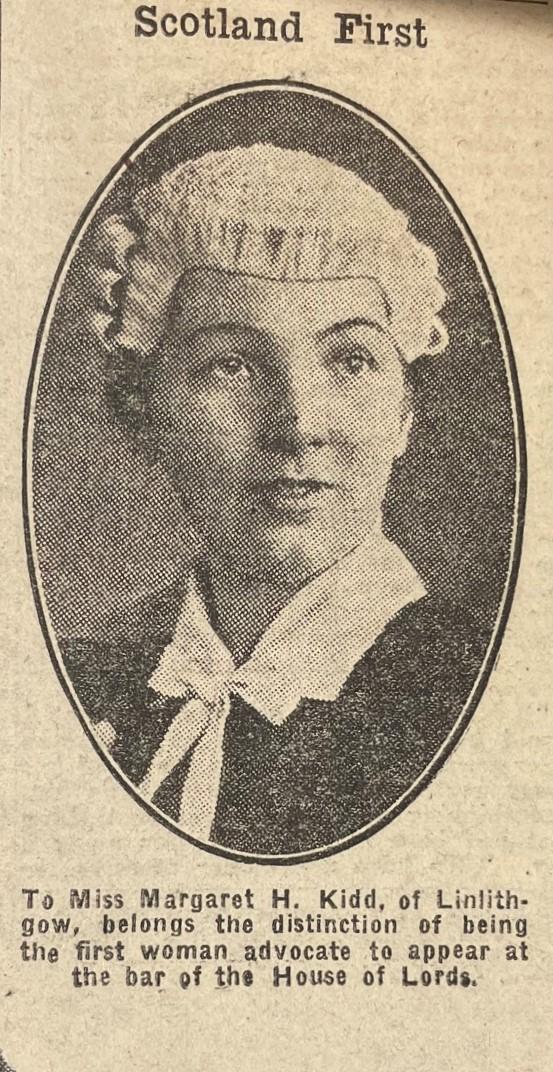

March 14th 1900 saw the birth of Scottish lawyer, Dame Margaret Kidd.
Margaret Henderson Kidd was a KC and a QC and during an eminent legal career, she racked up a number of pioneering ‘female firsts’ in what was then an entirely male dominated environment. Margaret became the first feminine member of the Scottish Bar in 1923, and uniquely, until 1948, she was its only female advocate. Margaret was also the first female lawyer to plead before the House of Lords and before a Select Committee of the House of Commons. In addition and significantly, Margaret became the first woman to become a King's Counsel in the United Kingdom. Furthermore, she was the first woman to officially occupy the post of Sheriff Principal for Dumfries and Galloway.
Kidd passed away on 22 March 1989 in Cambridge. A funeral service was held at the Canongate Kirk, Edinburgh. A eulogy by Lord Hope of Craighead concluded:
‘Her success was won by strength of character, courage and integrity and is a mark of her true qualities that, despite what might seem to be the revolutionary nature of her achievements, she always held the affection and respect of others.’
13 notes
·
View notes
Text
Thinking about those early jurists from the Roman Republic, when "lawyer" wasn't really a job yet. They weren't getting paid for it they just liked writing legal documents enough they did it as a hobby.
10 notes
·
View notes
Text

… The [Law] Register [of Alexander Hamilton, 1795-1804] is the first document of its kind made available in printed form and copiously annotated. Some readers will use the Register for information on a particular case or cases or for bibliographical aid in exploring court records. Apart from such use the document in its totality uniquely illuminates the practice of law during a formative period in legal development and growth of the bar in the State of New York.
Source: Hamilton, Alexander. The Law Practice of Alexander Hamilton, Documents and Commentary: Vol. V Ed. Goebel, Julius Jr., Smith, Joseph H. Columbia University Press, 1981 pg. 8 [Link Here]
And one reader will use the Register to outline part of a historical fiction epic. Definitely the unconventional answer.
#grace’s random rambles#alexander hamilton#historical alexander hamilton#the law practice of alexander hamilton#legal history#new york legal history#the american icarus#TAI#historical fiction#writers on tumblr#american history#writing community#historical research#historical documents
6 notes
·
View notes
Text
How Long Will The Second Redemption Last?
If you asked me to summarize the contemporary conservative legal mantra, it would go: "We had to suffer through the Second Reconstruction; so you're going to endure a Second Redemption."
There's little doubt in my mind that we are in the era of the Second Redemption: a fundamentally anti-democratic backlash against racial equality and progressivism more broadly that has captured elite institutions (particularly the federal courts) and seeks to entrench minoritarian political power as against liberal political priorities. In particular, the Supreme Court right now is not just conservative, it acts basically as the Republican Party's anti-democratic goon squad for the precise purpose of decoupling conservative political power from democratic accountability.
The cast of cases that fit this mold is sprawling. You have the cases that hoist nigh-insurmountable barriers to popular progressive priorities (Bruen, Citizens United, Parents Involved) , those overturn prior precedents which had secured rights and projects central to the liberal project (Dobbs, the Harvard/UNC affirmative actions cases), and -- most worrisome to me -- the cases which directly undermine the very structures of representative democracy that reflects the popular will (Shelby County, Rucho, Brnovich, the "Independent State Legislature" cases).
That conclusion felt quite the downer, and so it got me to thinking how long the Second Redemption is likely to last. Of course, the whole purpose of the Redemption -- first and second -- was to insulate itself from political recourse, so it is far from guaranteed that even wildly unpopular judicial machinations will be abled to be countered by "democratic" responses. Nonetheless, I am generally of the view that politics is cyclical -- periods of democratic progress are followed by backsliding and regress, which eventually yield to renewed progress again. The big question is simply how long the cycles last. And while there's obviously no guarantee that the Second Redemption will mirror the timeline of the first, it does offer at least a point of reference.
The original Redemption refers to the successful reclamation by White supremacists of political institutions in the American south that had temporarily been integrated during Reconstruction. Its beginnings are typically dated to 1877, and generally had succeeded by the 1890s. However, the "Long Redemption" -- if by that we mean the period in which the Supreme Court was generally a force for anti-democratic retrenchment as against progressive political initiatives -- continued for quite awhile after that, and probably should not be deemed over until the "switch in time" of 1936.*
1877 to 1936 -- that's nearly sixty years. Well, that's not too comforting, even if it does suggest that eventually the reign of the witches will pass. But then the next question is, "how far along are we in the Second Redemption"? Put differently, when did the Second Redemption begin? Many legal commentators have dated the beginnings of the earnest judicial backlash to the Second Reconstruction (typically dated roughly from 1945 - 1968) as starting in the 1980s with the Reagan administration (though some would place it even earlier, in the Nixon administration). If that's the case, we may be pretty far along in the process!
Of course, what settled for a conservative backlash in 1980 is positively tame compared to what's happening right now. But the Long Redemption was not a slow crest followed by an equally slow decline. Some of the most reactionary justices and judicial decisions were present right up to the end of the line (Justice McReynolds could give even the most racist 19th century SCOTUS justice a run for his money). There's good reason to think that anti-democratic forces in elite institutions will be at their most extreme and fight most fervently when they sense that the end may be nigh.
We can only hope.
* While 1936 is more often viewed as a dividing line for the Court's economic jurisprudence -- the abandonment of Lochner-ism and the accession to New Deal programs -- it also tracks when the Court started to pivot towards more concern for racial minority rights. Carolene Products, whose "footnote 4" became the ur-text of the liberal judicial approach to civil rights, was decided in 1938. Missouri ex rel. Gaines v. Canada, which augured the changing of the tides against school segregation, was decided that same year.
via The Debate Link https://ift.tt/OtD1lWM
23 notes
·
View notes
Photo

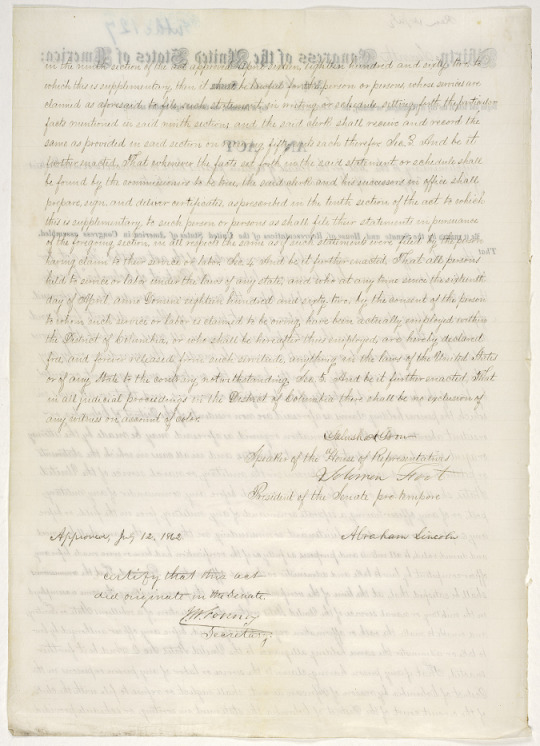
Supplementary DC Emancipation Act, 7/12/1862.
This Act explicitly allowed testimony by any witness regardless of race; previously, enslaved or freed Black people could not testify against white people.
File Unit: Laws of the United States; 1861-62, 37th Congress, 2nd Session, Part II, Public Laws and Private Laws, 12/24/1861 - 7/17/1862
Series: Enrolled Acts and Resolutions of Congress, 1789 - 2013
Record Group 11: General Records of the United States Government, 1778 - 2006
Transcription:
Thirty-Seventh Congress of the United States of America;
At the Second Session,
Begun and held at the city of Washington, on Monday, the Second day of December, one thousand eight hundred and sixty-one
AN ACT
Supplementary to the "Act for the release of certain persons held to service or labor in the District
of Columbia" approved April sixteen, eighteen hundred and sixty-two.
Be it enacted by the Senate and House of Representatives of the United States of America in Congress assembled,
That the oath or affirmation required by the second section of the act entitled "An act for
the release of certain persons held to service or labor in the District of Columbia" to verify
the statements or petitions in writing filed before the commissioners, under the act aforesaid,
of persons holding claims, as aforesaid, are infants or minors, be made by the guardian or by any
other person, whether separately or jointly, having the custody management, or control
by law of the person and property of such infants or minors, and that in all cases in
which the persons holding claims as aforesaid are no-residents of the District of Columbia, or
resident absentees, the oath or affirmation required as aforesaid may be made by the attorney
or agent of said non-resident or resident absentees; and in all cases in which the statements
or petitions, require as aforesaid, of persons in the military or naval service of the United
States, shall have been or may be hereafter verified before any commander of any military
post, or of any officer having a separate command of any military force in the field, or before
any captain, commander, or lieutenant commanding in the navy, the same shall be received
and deemed valid, to all intents and purposes, as fully as if the verification had been or were made before any
officer competent by law to take and administer oaths and affirmations. Provided, That the commissioners
shall be satisfied that, at the time of the verification aforesaid, the person making the same was employed
in the military or naval service of the United States within the jurisdiction of a rebellious State or Territory,
and unable to make the oath or affirmation required, as aforesaid, before any officer authorized by law
to take or administer the same, holding allegiance to the United States. Sec. 2. And be it further
enacted, That if any person having claim to the service or labor of any person or persons in the
District of Columbia by reason of African descent, shall neglect or refuse to file with the clerk
of the circuit court of the District of Columbia the statement in writing, or schedule provided
[page 2]
in the ninth section of the act approved April sixteen, eighteen hundred and sixty-two, to
which this is supplementary, then it shall be lawful for the person or persons, whose services are
claimed as aforesaid to file such statement in writing or schedule setting for the particular
facts mentioned in said ninth section; and the said clerk shall receive and record the
same as provided in said section on receiving fifty cents each therefor. Sec. 3. And be it
further enacted, That whenever the facts set forth in the said statement or schedule shall
be found by the commissioners to be true, the said clerk and his successors in office shall
prepare, sign, and deliver certificates, as prescribed in the tenth section of the act to which
this is supplementary, to such person or persons as shall file their statements in pursuance
of the foregoing section, in all respects the same as if such statements were filed by the person
having claim to their service or labor. Sec. 4. And be it further enacted, That all persons
held to service or labor under the laws of any state, and who at any time since the sixteenth
day of April, anno Domini eighteen hundred and sixty-two, by the consent of the person
to whom such service or labor is claimed to be owing, have been actually employed within
the District of Columbia, or who shall be hereafter thus employed, are hereby declared
free, and forever released from such servitude, anything in the laws of the United States
or of any State to the contrary notwithstanding. Sec. 5. And be it further enacted, That
in all judicial proceedings in the District of Columbia there shall be no exclusion of
any witness on account of color.
Galusha A. Grow
Speaker of the House of Representatives
Solomon Foot
President of the Senate pro tempore
Approved July 12, 1862.
Abraham Lincoln
I certify that this act
did originate in the Senate.
J.W. Forney
Secretary
#archivesgov#July 12#1862#1800s#Civil War#U.S. Civil War#DC#District of Columbia#Black history#African American history#legal history#emancipation
46 notes
·
View notes
Text
LJS 20 is a carta executoria, or a document to establish nobility, issued under the name of Philip II of Spain in favor of the brothers Juan, Francisco, and Alonso Gaytan de Cuenca in Andalusia, written in Granada and dated 12 September 1578.
Online: bit.ly/3B87aKm
#renaissance#16th century#spain#granada#legal history#nobility#rare books#book history#illuminated manuscript#illumination#illustration
19 notes
·
View notes
Text
The original public purpose for a citizens’ militia was not some theoretical worry about standing armies or an idealized right of citizens’ militias to resist federal power. Instead the original purpose was a practical concern that the antislavery North would leave the South vulnerable to slave revolts. Scalia omits that rationale. And of course he has to. Because grounding the case for “self-defense” that satisfies the NRA’s permissiveness of shooting Black children walking home with Skittles, in an amendment designed to help slavers keep people in bondage, would be a little too on the nose. If Scalia told the truth about the original purpose of the Second Amendment, people might realize that the Second Amendment is illegitimate, or that looking to the original intentions of the people who wanted it is monstrous, or both.
Now, one can argue that the Second Amendment has evolved, past its purely evil original intent, to encompass a right to self-defense. I’d be willing to hear such an argument, because I don’t think the Constitution means only what slavers and colonizers wanted it to mean. But conservatives won’t make that argument. Here we see another example where making the intellectually stronger argument doesn’t take conservatives where they want to go. If they accept that the Second Amendment has evolved to protect a different right than was originally intended, then they’d have to admit that gun restrictions can also evolve to better protect our modern society.
Elie Mystal, Allow Me to Retort
#currently reading#quotes#elie mystal#allow me to retort#the constitution#2nd amendment#legal history
4 notes
·
View notes
Photo
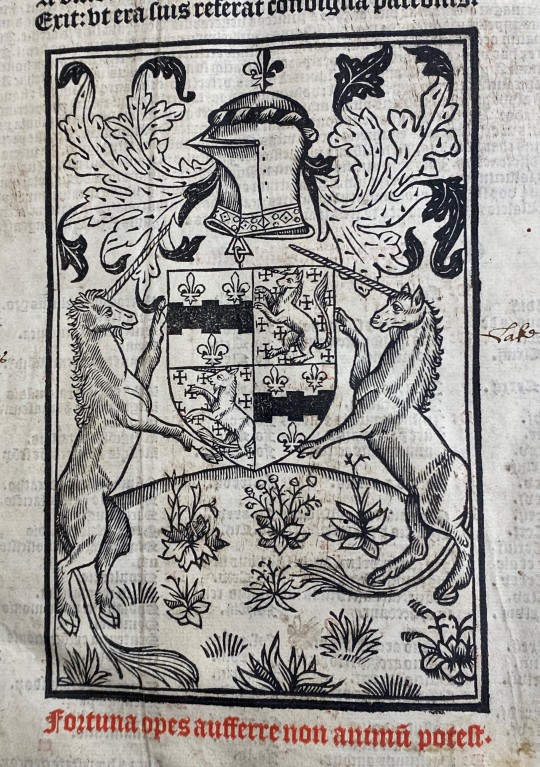
Another entry for our “dragons and unicorns” week: Two unicorns hold up a crest decorated with two more little unicorns, again from Constitutiones provinciales ecclesiae Anglicanae.
The caption reads: Fortuna opes aufferre non animu potest.
#woodcut#unicorn#unicorns#crest#heraldry#latin#rubricated text#gothic type#16th century#fleur-de-lis#armor#canon law#english law#legal history#old books#rare books#riesenfeld center#magical creatures#umn law#law library
244 notes
·
View notes
Note
Is it true that in early medieval ages a (potentially minor ) way to determine local rights / law was the word of the oldest person in town? A sort of anectodal oral record in addition to any hard evidence they may have written
Not just during the Early Middle Ages!
I've written about this a bit before, but in English and Anglosphere common law, there is a concept called "time immemorial" that describes when a given property right or use-right began, and makes it very difficult to change or challenge rights that are considered that old.
The traditional medieval formulation for "time immemorial" was that a given property, right, usage, or benefit had existed since "Time whereof the Memory of Man runneth not to the contrary." And in a medieval court of law, the way this period was established was by calling the oldest man in the parish to testify as to their memory - no other records required.
The reason why this method of ascertainment was used is that everyone understood that they were living in a society in which literacy rates were low and written records were uncommon. Thus, more weight was placed on oral tradition and human memory, which was encouraged by certain cultural traditions that sought to encourage the development of childhood memories associated with property rights.

For example, the custom of "beating the bounds" was established in which local communities would parade around the boundaries of their parish every seven years to remind everyone of where the boundary markers were supposed to be; while community leaders were encouraged to participate to demonstrate social solidarity, particular attention was paid to the participation of young children - who were variously either made to beat boundary markers with switches, were beaten with switches at boundary markers, had their heads knocked against the boundary markers, or were made to put their bare bottoms on the boundary markers.
I guess the idea was that symbolic violence or humiliation were believed to be a spur to memory formation.
39 notes
·
View notes
Text
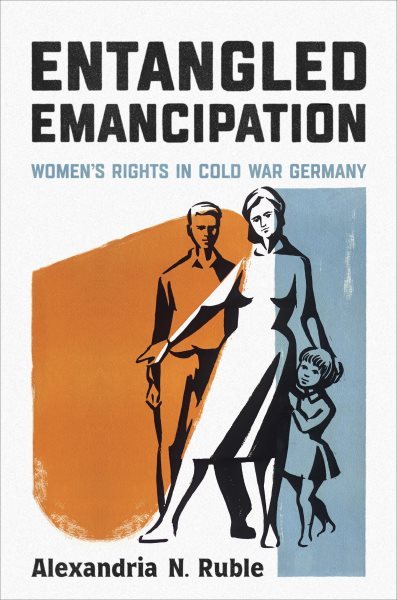
"Alexandria N. Ruble has written an essential history of women’s rights and the family in Cold War Germany. Although debates on gender equality and revisions of family law in the two Germanys were shaped by different ideological agendas and did not develop at the same pace, Ruble delivers a nuanced analysis of how they nonetheless moved in tandem. The book is a model of how to consider both German states in one frame."
10 notes
·
View notes
Photo
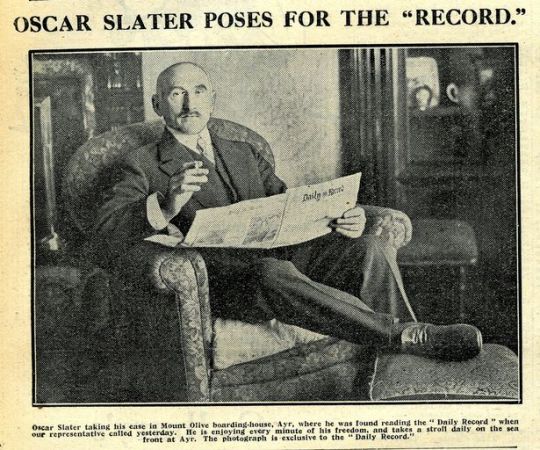

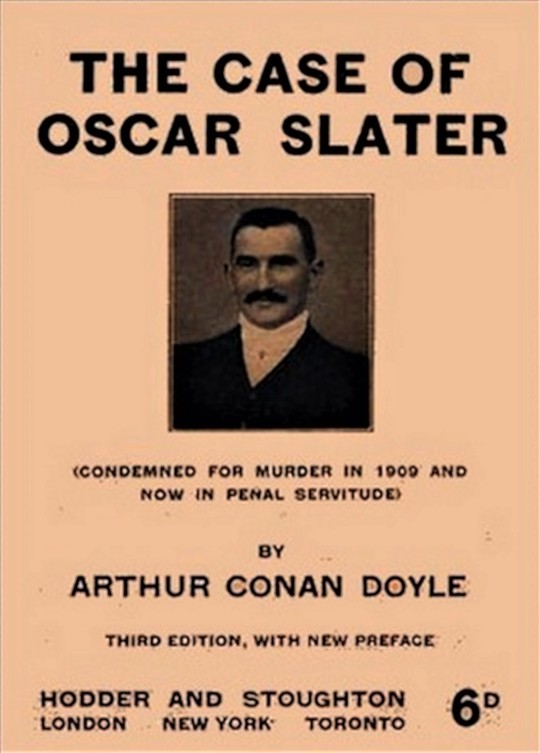
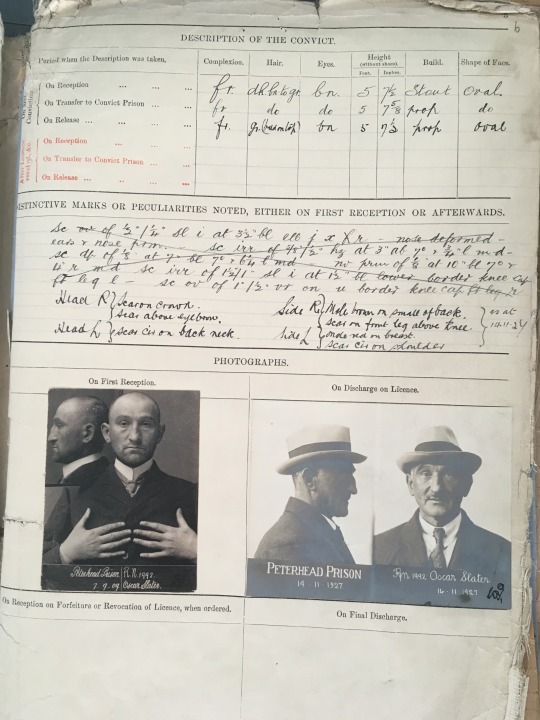
On May 25th 1909 Oscar Slater was found guilty of murdering Marion Gilchrist in Glasgow.
Another long post, previously I have only written smaller accounts of this case, I think it deserves something with more detail, so have lifted this from an article in The National.
The case of Oscar Slater is one of the most infamous miscarriages of justice in Scottish history. He served almost 19 years in prison for a crime he did not commit.
Here are the known facts about the Oscar Slater case. He was born Oscar Leschziner in Upper Silesia in Germany on January 8th, 1872. He moved to London in 1893, ostensibly to avoid being called up for military service, and began life as a gambler and bookmaker. He was twice acquitted of charges of violence.
He moved to Edinburgh in 1899 using the name Smiz and then to Glasgow in 1901 where he professed to be a dentist and a jewellery dealer, though the evidence is that he was a pimp and someone who dealt in stolen goods. He certainly took part in gambling at clubs in the city.
On December 21st, 1908, 83-year-old spinster Marion Gilchrist was savagely beaten to death in her own home in West Princes Street in Glasgow. A neighbour, Arthur Adams, disturbed the intruder who fled, and though Gilchrist had a fortune in jewellery in her wardrobe, the only item missing was a brooch.
The brutal murder shocked Glasgow, and the city’s police force came under great pressure from the press and public to find the murderer.
Within days, suspicion fell upon Slater. He had “fled” to America five days after the murder and had previously pawned a brooch which no-one could prove belonged to Gilchrist. Not that such details mattered to Glasgow police, who communicated to their counterparts in New York that a murder suspect was arriving – he was arrested before he even set foot on American soil.
Slater’s extradition was applied for and that was when the case took the first of many sensational turns. For Slater went before a court in New York state and demanded to be sent home.
Crime reporter William Roughead later gave this account of the proceedings: “Mr Miller, for the defence, said the defendant’s counsel felt that the British government had not established under the Treaty the case of identity which was necessary; that the defendant was innocent, and his counsel believed him innocent: but rather than have any misapprehension about his connection with Glasgow, the defendant had determined to go back and face any charge that might be made against him.
“He only asked that the evidence of the witnesses, who testified to his character in New York, should be admitted in the Scottish Court. The Commissioner said that a transcript of the proceedings would be certified as correct for production in Scotland.
Those full transcripts were never seen at Slater’s trial, during which the Crown carried out many tactics that would now be illegal – the Lord Advocate, Alexander Ure, later the Lord President Baron Strathclyde, shamefully rejected whole swathes of evidence that might have cleared Slater. He concealed the American transcripts, invented “facts” and went along with the police conspiracy to frame Slater that included a ludicrous identification parade featuring the medium-height and stocky Slater among a line-up of nine veritable giants – off duty Glasgow policemen.
Under police pressure, two witnesses, Gilchrist’s maid Helen Lambie and 14-year-old neighbour Mary Barrowman, perjured themselves by saying they had identified Slater at the scene – they had earlier told the detectives they could not completely identify the person they saw. One also said he was clean shaven.
Samuel Reid, Slater’s friend, testified that he had dined with Slater on the previous night.
Roughead reported: “On the night in question Slater’s moustache was growing, and was very noticeable, his hair being very black. No-one could have mistaken him for a clean-shaven man.” And the moustache was still there when Slater left for the US.
The experts could not agree on the murder weapon, supposedly found in Slater’s cases with a bloodstained waterproof. Gilchrist having been struck 40 to 50 times – one of her eyes was forced inside her head – the assailant would have been covered in blood from head to toe.
Roughead recounted: “The condition of the hammer and waterproof was of vital importance to the Crown case, for these were the only links between Slater and the murder. Apart from them, nothing incriminating was found in his possession.”
Not any of the clothing he was supposed to have been wearing was found, and the expert scientists disagreed as to whether the bloodstains were blood or other matter, and the hammer was said to have been too light to have killed her. The brooch Slater pawned? It belonged to his girlfriend and looked nothing like Gilchrist’s brooch.
Roughead again: “No proof was offered that he had any knowledge of the existence of Miss Gilchrist or of her jewels; none of the deceased’s property was traced to him, and nothing proved to be his was found in her house. With the exception of the disputable stains on the waterproof, no article of clothing belonging to him was bloodstained.”
Despite several witnesses providing him with an alibi, and proof that he had announced his trip to America long before the murder and was not “fleeing”, the “eyewitness” evidence was enough to convict Slater and he was sentenced to death, the execution set to take place before the end of May, 1909. It is said that Slater even heard the gallows beginning to be erected.
The public had been following the trial daily in the press and could see a stitch-up. More than 20,000 people signed a petition and Slater’s death sentence was commuted to life imprisonment in Peterhead jail.
Roughead was convinced that Slater had been set up and wrote his account of the biased trial and the evidence that had not been presented. Sir Arthur Conan Doyle became interested, and in 1912 published The Case Of Oscar Slater, effectively demolishing the Crown case in best Sherlock Holmes style.
The Secretary of State for Scotland, Thomas MacKinnon Wood, ordered a private inquiry, but it found no evidence of any conspiracy, despite a Glasgow detective, John Thomson Trench, providing evidence of just such a frame-up.
This is what he wrote: “Instead of finding anything or any one to corroborate Barrowman that she was at or near the close when the murderer left the close, everything goes to prove that her story of having seen the man was a cock-and-bull story of a young girl who was somewhat late in getting home and who wished to take the edge off by a little sensationalism.
“Slater on arriving in Glasgow (from New York) had with him nine packages: a number of these were trunks, and had not been opened. They were sealed by the American police.
“I was present when the packages were opened. Every package and trunk was carefully and systematically packed. A very considerable amount of time must have been spent in the packing. The linen and fine underwear were folded with camphor interposing between the layers. In no sense did the trunks reveal a hurried departure.
“From a trunk I lifted the hammer upon which the Crown built their theory of the commission of the crime. Alongside of the hammer were other tools which go to make up the card bought by Slater. The hammer weighed one-half pound. I saw nothing on the shaft to indicate to me that it had been either scraped or cleaned.
“For what it may be worth I look upon the hammer as a most unlikely instrument to have caused the injuries. Like Dr Adams, who was not used as a witness although the first medical man on the scene, I lean to the view that Miss Gilchrist was done to death by a chair.”
Trench paid for his truth with his career. He was even prosecuted on trumped-up charges and died a broken man in 1919. He has subsequently been proven correct on almost everything he wrote, yet his family have never had an apology and his name has not been restored to the Glasgow Police roll.
Conan Doyle was infuriated. He wrote: “How the verdict could be that there was no fresh cause for reversing the conviction is incomprehensible. The whole case will, in my opinion, remain immortal in the classics of crime as the supreme example of official incompetence and obstinacy.”
In 1927, Glasgow journalist William Park wrote The Truth About Oscar Slater, hinting that the real killer was Gilchrist’s nephew, Wingate Birell, a known criminal, though suspicion has long been cast on another relative, Francis Charteris, whose family were friendly with Lord Advocate Ure.
The book included more statements about the police coaching witnesses. Helen Lambie and Mary Barrowman retracted much of what they had testified and behind the scenes, the then Leader of the Opposition Ramsay MacDonald and Conan Doyle together brought the case back to the then Scottish Secretary Sir John Gilmour.
It was then that Scots law was altered – the recently created Scottish Court of Criminal Appeal, a long overdue institution, was allowed to hear cases from before 1926 for the first time, and they duly heard the case of Oscar Slater. In July 1928, he was freed, though not declared innocent, on a technicality – the judge had misdirected the jury about Slater’s character.
Oscar Slater received £6000 in compensation for nearly 19 years in jail. He was interned as an enemy alien at the start of World War II and died in Ayrshire in 1948, aged 78, never having been properly pardoned.
The identity of the real murderer is still disputed.
https://www.thenational.scot/news/15585823.the-oscar-slater-frame-up-how-a-murder-trial-changed-scots-law/
11 notes
·
View notes
Text
today i learned that boiling people alive was an actual legal punishment and not just something used for a horrifying ending in fromental halévy’s 1835 opera la juive
#opera tag#opera#boiled to death#la juive#legal history#halévy#fromental halévy#what the fuck#either way: capital punishment is bad. antisemitism is bad.
6 notes
·
View notes